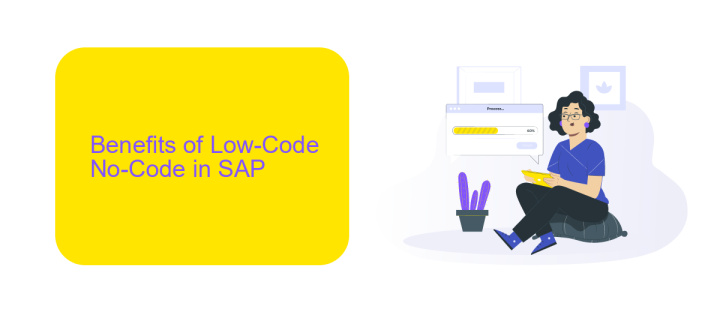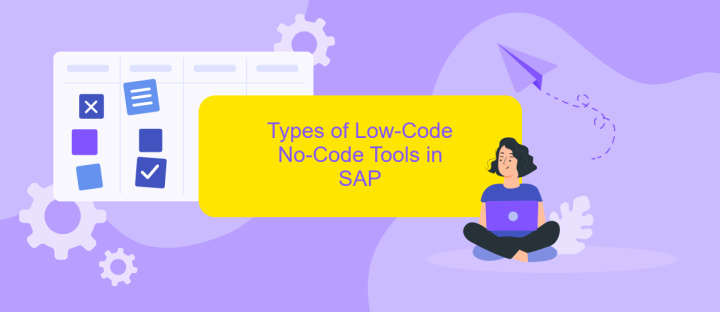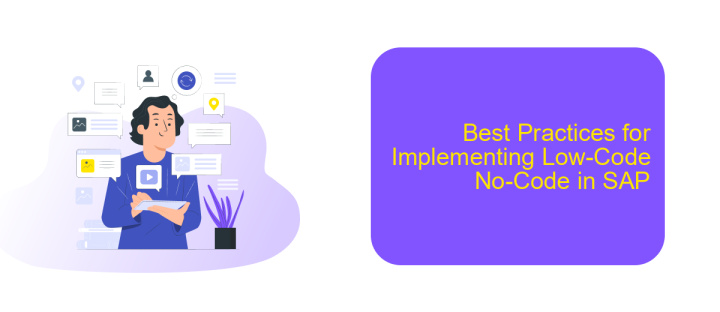SAP Low-Code No-Code
SAP Low-Code/No-Code platforms are revolutionizing the way businesses develop applications by enabling users with minimal coding skills to create powerful solutions. These tools streamline the development process, reduce time-to-market, and empower a broader range of employees to contribute to digital transformation efforts. This article explores the key features, benefits, and real-world applications of SAP's Low-Code/No-Code offerings.
Introduction
SAP Low-Code No-Code platforms are revolutionizing the way businesses approach software development, enabling rapid application creation with minimal coding expertise. These platforms empower users from various backgrounds to contribute to software projects, fostering innovation and accelerating digital transformation.
- Streamlined development processes
- Reduced dependency on specialized developers
- Enhanced collaboration across departments
One notable tool aiding in the integration of various services is ApiX-Drive. This service simplifies the process of connecting different applications and automating workflows without extensive coding. By leveraging such tools, businesses can seamlessly integrate SAP systems with other platforms, enhancing operational efficiency and data consistency.
Benefits of Low-Code No-Code in SAP

Implementing Low-Code No-Code (LCNC) solutions in SAP offers numerous benefits, significantly enhancing productivity and efficiency. By enabling users to create applications with minimal coding, LCNC platforms democratize app development, allowing non-technical staff to contribute to the digital transformation. This accelerates the development process, reduces dependency on IT departments, and fosters innovation by empowering business users to address their specific needs swiftly.
Furthermore, LCNC solutions in SAP streamline integration with other systems and services. Tools like ApiX-Drive facilitate seamless data synchronization and workflow automation across various applications, ensuring smooth and efficient operations. This integration capability not only enhances data accuracy and consistency but also reduces manual intervention, leading to cost savings and improved operational efficiency. Overall, the adoption of LCNC in SAP environments drives agility, fosters a culture of continuous improvement, and supports the rapid adaptation to changing business requirements.
Types of Low-Code No-Code Tools in SAP

SAP offers a variety of low-code and no-code tools designed to simplify application development and automate business processes. These tools cater to different needs and skill levels, enabling both professional developers and business users to create applications with minimal coding effort.
- SAP AppGyver: A no-code platform that allows users to build professional-grade applications without writing any code. It is suitable for users with no technical background.
- SAP Business Application Studio: A low-code development environment that provides a comprehensive set of tools for professional developers to build and extend SAP applications efficiently.
- SAP Process Automation: A tool that combines workflow management and robotic process automation (RPA) to streamline business processes with minimal coding.
- ApiX-Drive: An integration service that simplifies the process of connecting various applications and automating data transfer between them, enhancing the capabilities of SAP's low-code/no-code solutions.
By leveraging these tools, organizations can accelerate their digital transformation initiatives, reduce development costs, and empower employees to innovate and improve business processes without relying heavily on IT resources.
Best Practices for Implementing Low-Code No-Code in SAP

Implementing Low-Code No-Code (LCNC) solutions in SAP can significantly accelerate development processes and improve efficiency. To ensure success, it's essential to follow best practices that align with SAP's robust ecosystem. Start by thoroughly understanding your business requirements and identifying the processes that will benefit most from LCNC solutions.
Next, prioritize user training and change management. Educating your team about the capabilities and limitations of LCNC tools will foster a smoother transition and better adoption. Additionally, leveraging existing integration services like ApiX-Drive can streamline the process, making it easier to connect various applications and data sources without extensive coding.
- Define clear goals and objectives for your LCNC implementation.
- Ensure robust security and compliance measures are in place.
- Regularly monitor and evaluate the performance of your LCNC applications.
- Encourage collaboration between IT and business units to maximize benefits.
By following these best practices, you can effectively implement LCNC solutions within your SAP environment, driving innovation and operational efficiency. Remember, continual evaluation and adjustment are key to long-term success.


Future of Low-Code No-Code in SAP
The future of Low-Code No-Code (LCNC) in SAP looks promising as businesses increasingly seek agile solutions to adapt to rapidly changing market demands. With SAP's commitment to integrating LCNC platforms, organizations can expect to streamline their application development processes, reducing the dependency on traditional coding skills. This democratization of app development allows business users to create and modify applications swiftly, enhancing productivity and innovation within the enterprise.
Moreover, the integration of services like ApiX-Drive into SAP's LCNC ecosystem will further enhance its capabilities. ApiX-Drive facilitates seamless integration between various applications and services, enabling businesses to automate workflows and data exchanges without extensive coding. This synergy between LCNC tools and integration services ensures that organizations can build robust, interconnected systems efficiently. As SAP continues to evolve its LCNC offerings, the potential for accelerated digital transformation and operational efficiency becomes increasingly attainable for enterprises of all sizes.
FAQ
What is SAP Low-Code No-Code?
How does Low-Code No-Code benefit businesses?
What kinds of applications can be built with SAP Low-Code No-Code tools?
How can businesses integrate SAP Low-Code No-Code applications with other systems?
Do Low-Code No-Code platforms compromise on security and compliance?
Strive to take your business to the next level, achieve your goals faster and more efficiently? Apix-Drive is your reliable assistant for these tasks. An online service and application connector will help you automate key business processes and get rid of the routine. You and your employees will free up time for important core tasks. Try Apix-Drive features for free to see the effectiveness of the online connector for yourself.

